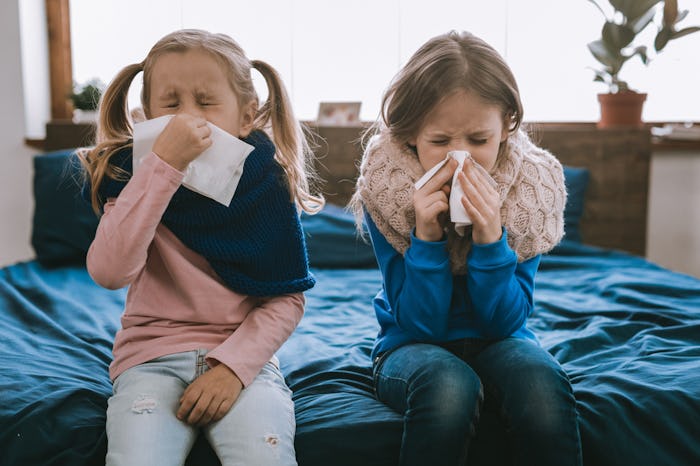Life

7 Things Teachers Want Parents To Know About Flu Season, Which Will Peak Soon
Now that winter's here, I and fellow teachers everywhere are running through all the boxes of tissues and bottles of hand sanitizer that we stockpiled back in September. We spend our days helping blow little noses and listening to coughs punctuate our class meetings. But what worries us most is looking at our attendance sheets and seeing a string of "absent" marks for students home sick. The facts about flu season are something we teachers learn early in our careers, and we don't like seeing your children feverish, achy, and miserable any more than you do.
According to the Centers for Disease Control (CDC), between 6 and 7 million people have already contracted the flu this season, and more than 70,000 have been hospitalized from flu or flu complications. And the season is far from over: Many more patients will be visiting the doctor or ER before the danger period has passed in late spring.
With figures this large, it's a pretty good bet that your household will be at risk at some point. There's no absolute way to guarantee your kids will never get sick, but knowing the facts about flu season and prevention will help you arm yourself and your children as best as you can against the disease.
Flu Season Starts Early And Runs Late
The threat of catching the flu doesn't magically go away the minute you take down your lawn Santas and blinking house lights. According to the CDC, the flu season for the last 35 years has begun in October and lasted right through May. The number of flu cases peaks most sharply in February, with December, January, and March coming closely behind. That's a pretty large chunk of the year, and an even larger chunk of the school year for kids.
Flu Is *Way* Worse Than A Cold
A cold might make you feel lousy, but the sneezing, sniffling, and scratchy throat are generally tolerable enough not to interfere with daily life. The flu, on the other hand, hits quickly and hard, with miserable symptoms such as fever, muscle aches, chills, headache, and dry cough, explained the Mayo Clinic. While most people recover with home treatment, at-risk patients — among them children under 5, the elderly, and people with chronic illnesses like asthma — can develop complications such as pneumonia. For some, this can be deadly. As reported by Parents, 180 children died during the 2017-18 flu season, the second-deadliest season in 14 years.
A Flu Shot Is A Good Idea
Getting vaccinated against the flu is one of the best ways to avoid contracting the virus; the vaccine can also help reduce the severity of symptoms if you do become sick. The CDC estimates that if vaccine rates increased by just 5 percent across the population, an additional 483,000 illnesses and 6,950 hospitalizations could be prevented.
Children 6 months to 8 years may need two doses of flu vaccine, if this is their first immunization against the disease, explained the CDC; the first dose preps the immune system for the second. After that, a child needs only one flu shot per year. Talk to your doctor or health care provider about the appropriate dosage for your child.
Your Child May Be Required To Have The Shot
Depending on where you live, you may have no choice but to have your child vaccinated. According to the Immunization Action Coalition, children in child-care facilities in Connecticut, Ohio, Rhode Island, New Jersey, and New York City's five boroughs are required to have the flu shot in order to stay in preschool or day care. Connecticut also requires flu shots for kindergartners. You may be able to request an exemption on religious or medical grounds, but that's something you'll have to talk to your doctor and school about.
The Flu Can Seriously Mess With School
A cold might keep a child home from school for a day, just for a little extra juice, naptime, and TLC. With the flu, we're talking at least a week off, if not more, and it might be a while before your child is back to their old energetic self. That's a lot of missed lessons, homework, and social interaction.
What's more, the flu virus is contagious, and children can spread it up to a week after catching it themselves, according to the CDC. In a busy classroom where kids work close together, that can mean a whole outbreak.
Don't Ignore Symptoms
Although flu symptoms can appear a day or two after children are actually infected, they're pretty hard to miss when they do emerge. Yet teachers often see students come in to class looking lethargic and pale, or complaining of a sore throat and aches, and sure enough, they're spiking a fever by lunchtime. If your child wakes up with flu-like symptoms, or just doesn't seem "right," play it safe and keep them home rather than sending them to school and hoping for the best.
Flu Prevention Starts At Home
Apart from having your children vaccinated, practicing good hygiene is the best way to avoid getting sick, according to WebMD. Teach your children to wash their hands or use hand sanitizer after touching or blowing their noses. (Yeah, that means a lot of hand-cleaning, but it's worth it.) Show them how to cough and sneeze into the crook of their arm or their shoulder, to avoid infecting others. A sneeze or cough can spread germ-ridden droplets as far as six feet away.
Other healthy habits can keep your kids' immune systems strong and better able to fight off any unwanted viruses. Keep those nutritious meals coming, schedule exercise into your day, and stand firm about an early bedtime, advised VeryWellFamily. As with any battle, the war against flu needs a good defense if you want your kids to come out winners.